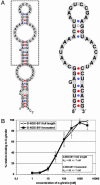Inhibition of ghrelin action in vitro and in vivo by an RNA-Spiegelmer
- PMID: 15329412
- PMCID: PMC516544
- DOI: 10.1073/pnas.0404175101
Inhibition of ghrelin action in vitro and in vivo by an RNA-Spiegelmer
Abstract
Employing in vitro selection techniques, we have generated biostable RNA-based compounds, so-called Spiegelmers, that specifically bind n-octanoyl ghrelin, the recently discovered endogenous ligand for the type 1a growth hormone secretagogue (GHS) receptor. Ghrelin is a potent stimulant of growth hormone release, food intake, and adiposity. We demonstrate that our lead compound, L-NOX-B11, binds ghrelin with low-nanomolar affinity and inhibits ghrelin-mediated GHS-receptor activation in cell culture with an IC(50) of 5 nM. l-NOX-B11 is highly specific for the bioactive, n-octanoylated form of ghrelin. Like the GHS receptor, it does not recognize the inactive unmodified peptide and requires only the N-terminal five amino acids for the interaction. The i.v. administration of polyethylene glycol modified l-NOX-B11 efficiently suppresses ghrelin-induced growth hormone release in rats. These results demonstrate that the neutralization of circulating bioactive ghrelin leads to inhibition of ghrelin's secretory effects in the CNS.
Figures




Similar articles
-
Anti-ghrelin Spiegelmer NOX-B11 inhibits neurostimulatory and orexigenic effects of peripheral ghrelin in rats.Gut. 2006 Jun;55(6):788-92. doi: 10.1136/gut.2004.061010. Epub 2005 Jun 30. Gut. 2006. PMID: 15994217 Free PMC article.
-
Ghrelin neutralization by a ribonucleic acid-SPM ameliorates obesity in diet-induced obese mice.Endocrinology. 2006 Mar;147(3):1517-26. doi: 10.1210/en.2005-0993. Epub 2005 Dec 8. Endocrinology. 2006. PMID: 16339202
-
Hormone fatty acid modifications: gram negative bacteria and vertebrates demonstrate common structure and function.Med Hypotheses. 2006;67(3):513-6. doi: 10.1016/j.mehy.2006.03.010. Epub 2006 Apr 27. Med Hypotheses. 2006. PMID: 16644138
-
Ghrelin: structure and function.Physiol Rev. 2005 Apr;85(2):495-522. doi: 10.1152/physrev.00012.2004. Physiol Rev. 2005. PMID: 15788704 Review.
-
Structure and regulation of the growth hormone secretagogue receptor.Minerva Endocrinol. 2002 Dec;27(4):243-56. Minerva Endocrinol. 2002. PMID: 12511847 Review.
Cited by
-
Recent advances in potential clinical application of ghrelin in obesity.J Obes. 2012;2012:535624. doi: 10.1155/2012/535624. Epub 2012 Feb 20. J Obes. 2012. PMID: 22523666 Free PMC article.
-
Aptamer Technologies in Neuroscience, Neuro-Diagnostics and Neuro-Medicine Development.Molecules. 2024 Mar 2;29(5):1124. doi: 10.3390/molecules29051124. Molecules. 2024. PMID: 38474636 Free PMC article. Review.
-
Oligoclonal antibody targeting ghrelin increases energy expenditure and reduces food intake in fasted mice.Mol Pharm. 2012 Feb 6;9(2):281-9. doi: 10.1021/mp200376c. Epub 2011 Dec 23. Mol Pharm. 2012. PMID: 22149064 Free PMC article.
-
Neonatal ghrelin programs development of hypothalamic feeding circuits.J Clin Invest. 2015 Feb;125(2):846-58. doi: 10.1172/JCI73688. Epub 2015 Jan 20. J Clin Invest. 2015. PMID: 25607843 Free PMC article.
-
Late onset of Ccl2 blockade with the Spiegelmer mNOX-E36-3'PEG prevents glomerulosclerosis and improves glomerular filtration rate in db/db mice.Am J Pathol. 2008 Mar;172(3):628-37. doi: 10.2353/ajpath.2008.070601. Epub 2008 Feb 7. Am J Pathol. 2008. PMID: 18258851 Free PMC article.
References
MeSH terms
Substances
LinkOut - more resources
Full Text Sources
Other Literature Sources

